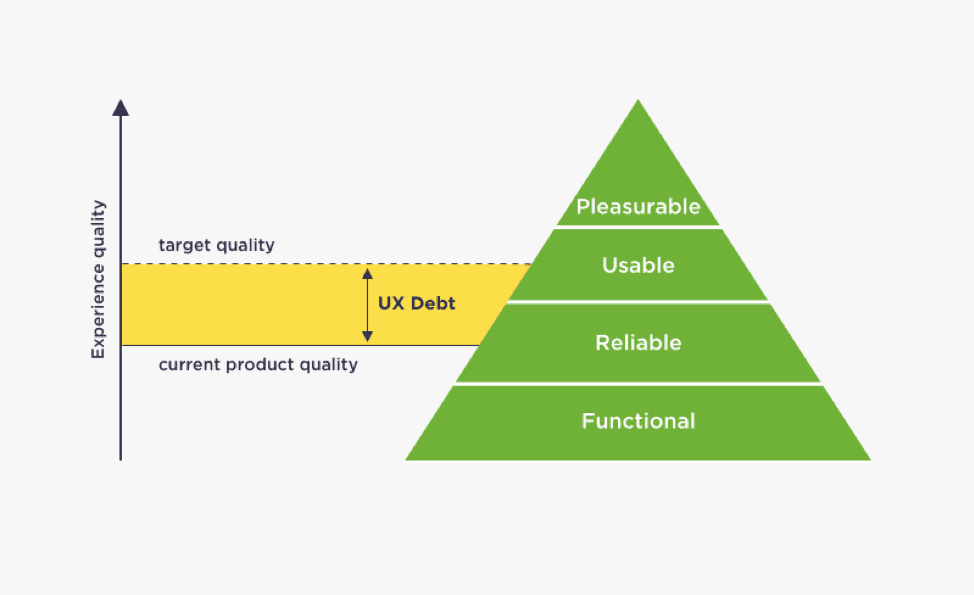UX Debt is real and every digital product is in the red…
Some background on the concept
User experience debt is similar to real-life debt; we get something in the present, but only pay for it in the future. Until the debt is paid off, interest rates rise as a permanent cost.

The UX debt concept was derived from technical (or tech) debt. The term “technical debt” was coined by Ward Cunningham in 1992 who realized that cutting corners with technology and releasing software too quickly can result in additional costs (interest) after the launch.
- “Those internal things that you choose not to do now, but which will impede future development if left undone in software projects.”
— Ward Cunningham
Later, Joshua Kerievsky extended the metaphor to architecture and design and applied it to user experience design using the term “User Experience (UX) Debt”.
Kerievsky explained that, “like technical debt, UX debt will eventually come due — usually when the gap between product performance and product vision becomes critically untenable, and the software provides an incoherent, unstable and unfriendly experience for users — causing less customer satisfaction and possible customer erosion”.
So, what is UX Debt?
UX debt is an accumulation of design and development decisions that negatively impact the users of a product or service. When product decisions compromise the user experience, the result is UX debt.
It means you’re fully aware that your user experience is not optimized to its full potential, but because of time constraints and the resources you have available, you make a compromise to restrain the scope of your solution so that it still solves a user need in your first version but it isn’t as easy to use and elegant as you would like it to be. MVPs can be fraught with UX Debt if not produced with an agile or lean UX framework.
To put it another way, UX debt measures the number and magnitude of potential product enhancements that would improve the user experience.
Like tech debt, UX debt often happens when designers and researchers are working under tight timelines or unrealistic project constraints. Other factors that contribute to UX debt include:
- Ignore brand standards and style guides
- Misinterpreting the product vision
- Skipping user testing
- Design by committee
- Acquiring or merging with other products
- Poor communication or documentation
- Insufficient QA testing
- Legacy code or delayed refactoring
Types of UX debt?
UX debt can be categorized into two categories:
- Intentional UX debt can be the result of deliberate corner-cutting due to project constraints (budget, time, resources, etc.).When the focus is on new features and when UX is treated as an island. Having a “don’t fix what’s not broken” mindset, and design ideas that could simplify user interactions but are considered too complex to implement within a specific time-frame, and as a result, are sacrificed.
- Unintentional UX debt is less obvious since it results from a lack of information or misconceptions and assumptions about the end-users about their needs, abilities or expectations over time. If time and resources are invested without validating assumptions or legitimate insights, the accumulation of UX debt could result in product failure.
How to know when you’re creating UX Debt?
I’m sure you’ve heard one of these lines before:
- We don’t have time
- We’ll fix it later
- We’ll improve it on the next release
- We don’t have resources
- We can train them with tutorials
Resolving your UX debt
Just like paying off financial debt, it can be daunting to pay down your UX debt. Each team treats UX debt differently, there is no best way to do it. It really depends on how your team works.
- One good approach is to negotiate with the team a specific number of story points to pay down UX debt during each sprint or every other sprint.
- Another approach is to plan UX debt clean up in specific times of the year, like for example when the workload is lighter or if that is never an option, plan to do it ever trimester or every quarter.
UX debt is real and every digital product has some to repay. It isn’t always avoidable but teams can organize and collaborate around how to address it.
Acknowledging and formulating a plan for paying UX debt back over time will help you resolve it before your users start to notice. Keep your relationship with your users healthy and strong.
Another important thing to take away is that UX debt should be understood as a responsibility of the entire organization — not just the UX team. It takes a good working relationship with your entire team to ensure that UX debt is given the attention it deserves.



